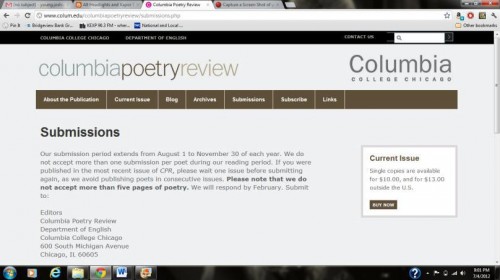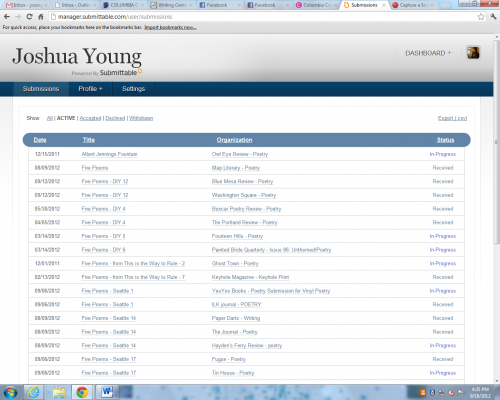
The Submission Game: Some Dos & Don’ts for Submitting Your Writing to Journals
[flickr id=”8001091791″ thumbnail=”medium” overlay=”true” size=”original” group=”” align=”none”]
I thought it might be helpful to put together a list of things I’ve learned as I’ve become more comfortable with submitting my work to journals. Once you get the hang of it, this whole process becomes second nature.
1. Knowing Where to Submit.
It’s hard (impossible) to read every journal, and publishing is really a crap-shoot. Sometimes, it’s the ones you least expect that love what you send in. But, you should read enough of a journal to get a feel for it before you submit.
Submitting is about talent, but it’s also about luck. It requires perseverance. Eventually, you’ll be able to gauge whether or not they are receptive to your work.
2. Do You Have a Grail List?
A Grail List is ten to twenty journals that you want to see your poems in. It will change, grow, and mutate.
Here’s part of mine:
3. Submission Guidelines
Know the guidelines. They’re usually the same for most publications: Submit 3-5 poems in a single word document with a short cover letter. You always want to double check the guidelines, though. Some are very, very different.
4. A Good, Short Cover Letter
You want to think of a cover letter as “get in, get out” (unless the guidelines say otherwise). Don’t over-do it.
Here’s an example:
[Your Address]
[Journal Name]
Dear [Editor Name],
I am interested in submitting five poems for your consideration. I study poetry in the MFA program at Columbia College Chicago. [You could mention something nice about the journal, but don’t force it]
Thank you for your time. I look forward to hearing from you.
Sincerely,
[Your Name]
5. You Don’t Have to Pay to Submit…
…unless you love the journal…and want to support them. Submission fees help the journal, obviously. But really, if you want to support, buy their magazine (subscribe?)!
The cost of submissions really adds up.
6. Submit Batches to Many Places
Pick 3-5 poems that somewhat work together as one batch. Pick 4-10 journals on the same tier and submit. Keep good records (spreadsheet?). Make sure they allow simultaneous submission.
Look out for: “We Do Not Accept Simultaneous Submissions”
Look into getting a Submittable account. Many journals use this submission manager, and it makes submitting so easy! It tells you not only when they accept or reject your submission, but also when they’re looking at your work.
7. Print or Online?
Either one is legit, as long as you like the journal.
8. What Jenny Boully Says
* A good goal is to have more than 50% from a manuscript published before it becomes a book. (There are exceptions—my first book only had 20%).
* Don’t keep yourself from submitting because you think your work isn’t ready. A lot of writers submit their work as a means of work-shopping. When you’re no longer in the safe walls of grad school, your gauge may be those journals—rejection, acceptance, editor notes. That interaction with your work is what you’ll have to work with, and it’s better to start witnessing that world now, while you’re still in school.
9. Good Luck!
Remember: There are so, so many writers out there, and so, so many editors. You never know who is reading it and when—there are bad moods, bad readers, and bad times. Keep at it. Someone will eventually read it with care.
Good Luck! Get Started…NOW!


